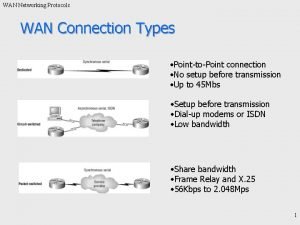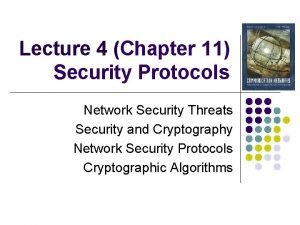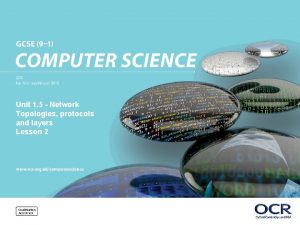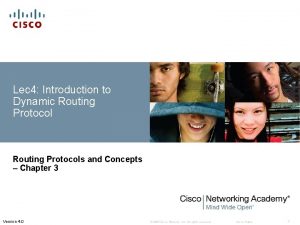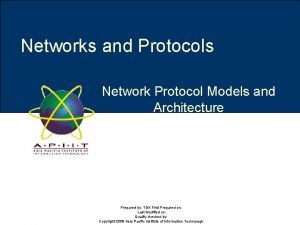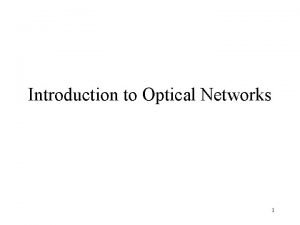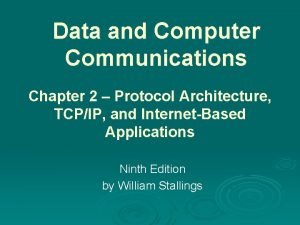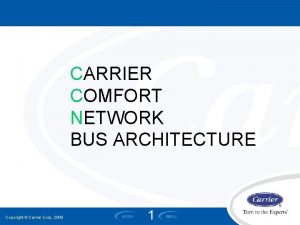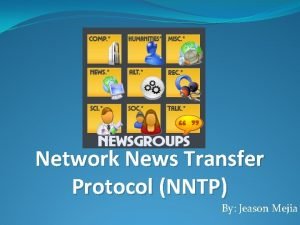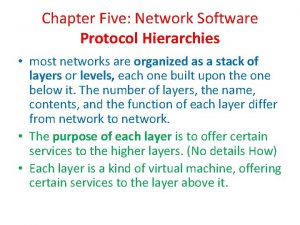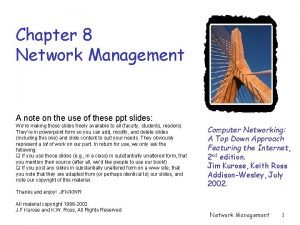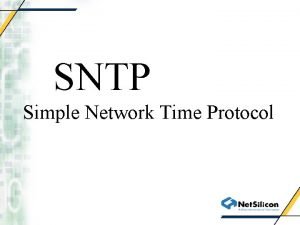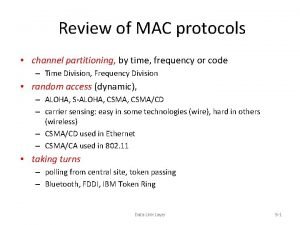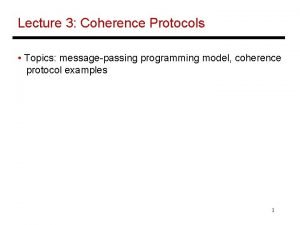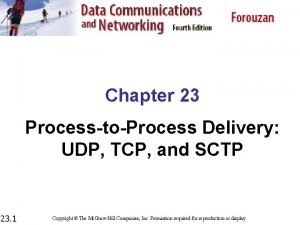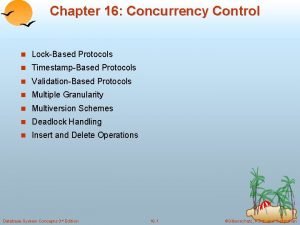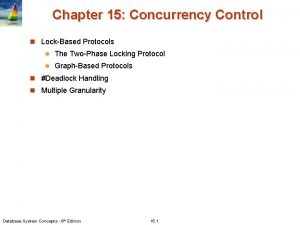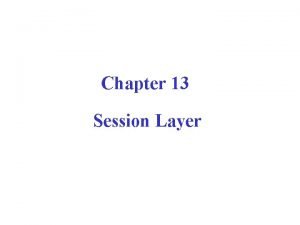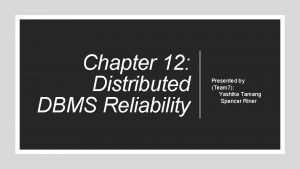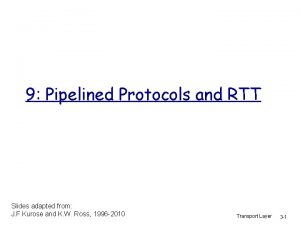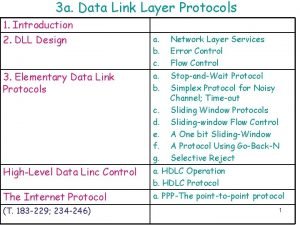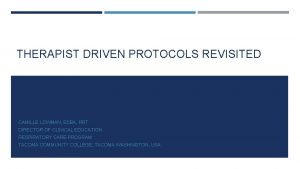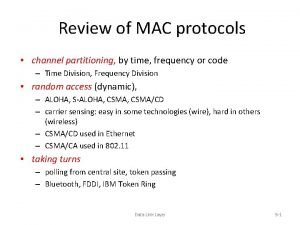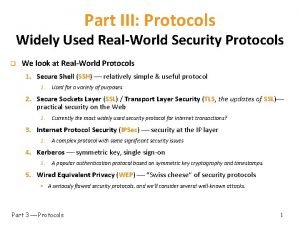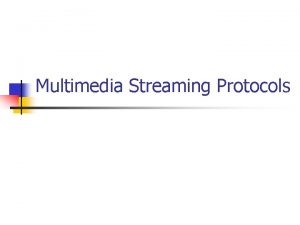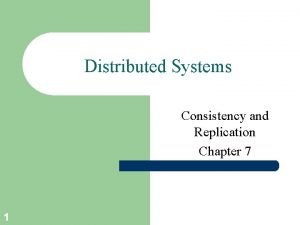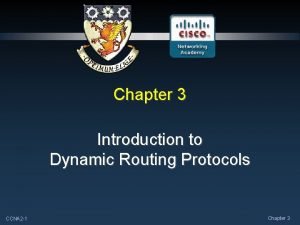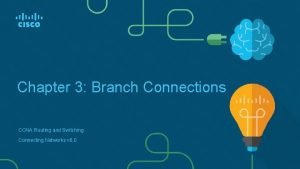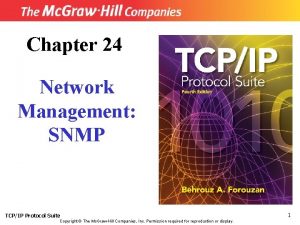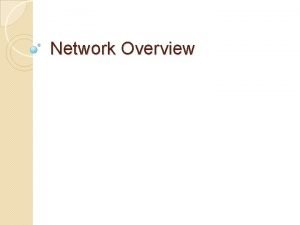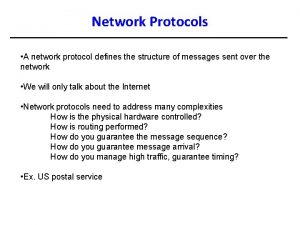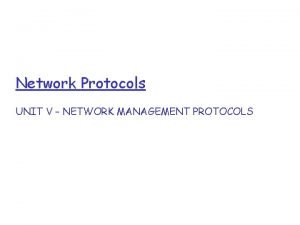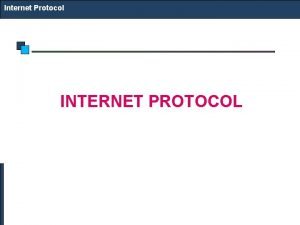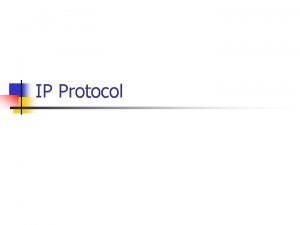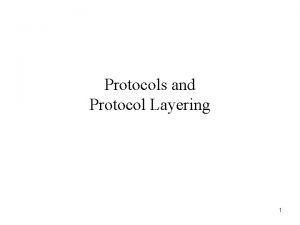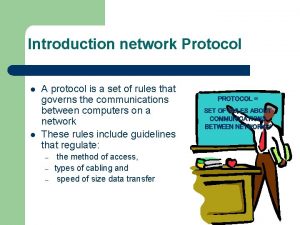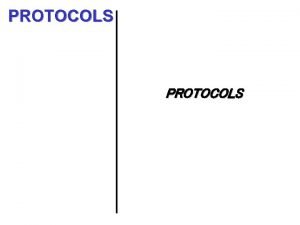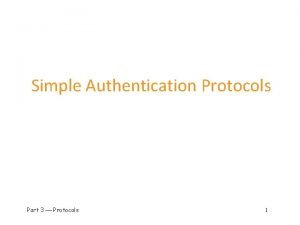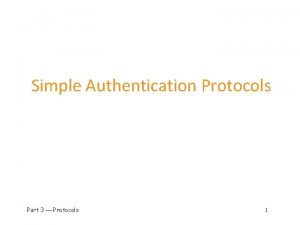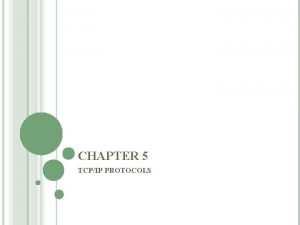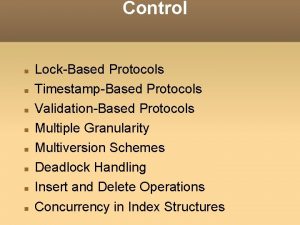Network Protocols Introduction to Protocols n Protocol n



















































- Slides: 51

Network Protocols

Introduction to Protocols n Protocol ¡ ¡ n Rules network uses to transfer data Protocols that can span more than one LAN segment are routable Multiprotocol network ¡ Network using more than one protocol

TCP/IP OSI Model n Transmission Control Protocol/Internet Protocol (TCP/IP) ¡ Suite of small, specialized protocols called subprotocols TCP/IP

TCP/IP model n n n File Transfer Protocol (FTP) Hypertext Transfer Protocol (HTTP) Simple Mail Transfer Protocol (SMTP) Domain Name System (DNS) Trivial File Transfer Protocol (TFTP) The common transport layer protocols include: n Transport Control Protocol (TCP) n User Datagram Protocol (UDP) The primary protocol of the Internet layer is: n Internet Protocol (IP)

TCP/IP model

TCP/IP Compared to the OSI Model n n Application layer roughly corresponds to Session, Application, and Presentation layers of OSI Model Transport layer roughly corresponds to Transport and session layers of OSI Model Internet layer is equivalent to Network layer of OSI Model Network Interface layer roughly corresponds to Data Link and Physical layers of OSI Model

The TCP/IP Core Protocols n Certain subprotocols of TCP/IP suite ¡ ¡ n Operate in Transport or Network layers of OSI Model Provide basic services to protocols in other layers of TCP/IP TCP and IP are most significant core protocols in TCP/IP suite

Internet Protocol (IP) n n Provides information about how and where data should be delivered Subprotocol that enables TCP/IP to internetwork ¡ ¡ To internetwork is to traverse more than one LAN segment and more than one type of network through a router In an internetwork, the individual networks that are joined together are called subnetworks

Internet Protocol (IP) n IP datagram ¡ ¡ IP portion of TCP/IP frame that acts as an envelope for data Contains information necessary for routers to transfer data between subnets

IP header format

IP header format: Version • 4 bits. • Indicates the version of IP currently used. – IPv 4 : 0100 – IPv 6 : 0110

IP header format: Header length • 4 bits. • IP header length : Indicates the datagram header length in 32 bit words (4 bits), and thus points to the beginning of the data.

IP header format: Service type • 8 bits. • Specifies the level of importance that has been assigned by a particular upper-layer protocol. • Precedence. • Reliability. • Speed.

IP header format: Total length • 16 bits. • Specifies the length of the entire IP packet, including data and header, in bytes.

IP header format: Identification • 16 bits. • Identification contains an integer that identifies the current datagram. • Assigned by the sender to aid in assembling the fragments of a datagram.

IP header format: Flags • 3 bits. • The second bit specifying whether the packet can be fragmented. • The last bit specifying whether the packet is the last fragment in a series of fragmented packets.

IP header format: Fragment offset • 13 bits. • The field that is used to help piece together datagram fragments. • The fragment offset is measured in units of 8 octets (64 bits). • The first fragment has offset zero.

IP header format: Time to Live • 8 bits. • Time-to-Live maintains a counter that gradually decreases to zero, at which point the datagram is discarded, keeping the packets from looping endlessly.

IP header format: Protocol • 8 bits. • Indicates which upper-layer protocol receives incoming packets after IP processing has been completed • 06 : TCP • 17 : UDP

IP header format: Header checksum • 16 bits. • A checksum on the header only, helps ensure IP header integrity.

IP header format: Addresses • 32 bits each. • Source IP Address • Destination IP Address

IP header format: Options • Variable length. • Allows IP to support various options, such as security, route, error report. . .

IP header format: Padding • The header padding is used to ensure that the internet header ends on a 32 bit boundary.

Ethereal Lab (Analyzing the IP Header) Use Ethereal to capture some frames. Open one of the frames and look at the IP header. Based on what you see, try to answer the following: n What is the IP version? n What is the IP header length? n What is the type of Service? n What is the time to live? n What is the protocol? n What is the source IP address? n What is the destination IP address?

Internet Protocol (IP) n IP is an unreliable, connectionless protocol, which means it does not guarantee delivery of data ¡ Connectionless n Allows protocol to service a request without requesting verified session and without guaranteeing delivery of data

Transport Control Protocol (TCP) n TCP ¡ Provides reliable data delivery services ¡ Connection-oriented subprotocol n n Requires establishment of connection between communicating nodes before protocol will transmit data TCP segment ¡ ¡ Holds TCP data fields Becomes encapsulated by IP datagram

Transport Control Protocol (TCP) n Port ¡ Address on host where application makes itself available to incoming data

Ethereal Lab (Analyzing the TCP Header) Use Ethereal to capture some frames. Open one of the frames and look at the TCP header. Based on what you see, try to answer the following: n What is the source Port? n What is the destination Port? n What is the sequence Number? n What Is the Acknowledgement Number? n What is the header Length?

Additional Core Protocols of the TCP/IP Suite n User Datagram Protocol (UDP) ¡ n Internet Control Message Protocol (ICMP) ¡ n Connectionless transport service Notifies sender of an error in transmission process and that packets were not delivered Address Resolution Protocol (ARP) ¡ ¡ Obtains MAC address of host or node Creates local database mapping MAC address to host’s IP address

ARP Lab

TCP/IP Application Layer Protocols n Telnet ¡ n File Transfer Protocol (FTP) ¡ n Used to send and receive files via TCP/IP Simple Mail Transfer Protocol (SMTP) ¡ n Used to log on to remote hosts using TCP/IP protocol suite Responsible for moving messages from one e-mail server to another, using the Internet and other TCP/IP-based networks Simple Network Management Protocol (SNMP) ¡ Manages devices on a TCP/IP network

Labs n n FTP Lab Telnet Lab

Addressing in TCP/IP n IP Address ¡ ¡ Logical address used in TCP/IP networking Unique 32 -bit number n ¡ Divided into four groups of octets (8 -bit bytes) that are separated by periods IP addresses are assigned and used according to very specific parameters

Addressing in TCP/IP n n Though 8 bits have 256 possible combinations, only the numbers 1 through 254 are used to identify networks and hosts Number 255 is reserved for broadcasts ¡ Broadcast are transmissions to all stations on a network

Addressing in TCP/IP n Loopback address ¡ ¡ n IP address reserved for communicating from a node to itself Value of the loopback address is always 127. 0. 0. 1 Internet Corporation for Assigned Names and Numbers (ICANN) ¡ Non-profit organization currently designated by U. S. government to maintain and assign IP addresses

Addressing in TCP/IP n Firewall ¡ ¡ ¡ n Specialized device (typically a router) Selectively filters or blocks traffic between networks May be strictly hardware-based or may involve a combination of hardware and software Host ¡ Computer connected to a network using the TCP/IP protocol

Addressing in TCP/IP n In IP address 131. 127. 3. 22, to convert the first octet (131) to a binary number: ¡ ¡ ¡ On Windows 2000, click Start, point to Programs, point to Accessories, then click Calculator Click View, then click Scientific (make sure Dec option button is selected) Type 131, then click Bin option button n The binary equivalent of number 131, 10000011, appears in the display window

Addressing in TCP/IP n Static IP address ¡ n IP address manually assigned to a device Dynamic Host Configuration Protocol (DHCP) ¡ ¡ Application layer protocol Manages dynamic distribution of IP addresses on a network

Viewing Current IP Information

Viewing Current IP Information

Addresses and Names n In addition to using IP addresses, TCP/IP networks use names for networks and hosts ¡ ¡ ¡ Each host requires a host name Each network requires a network name, also called a domain name Together, host name and domain name constitute the fully qualified domain name (FQDN)

Net. BIOS and Net. BEUI n Network Basic Input Output System (Net. BIOS) ¡ ¡ ¡ Originally designed by IBM to provide Transport and Session layer services Adopted by Microsoft as its foundation protocol Microsoft added Application layer component called Net. BEUI

Net. BIOS and Net. BEUI n Net. BIOS Enhanced User Interface ¡ ¡ ¡ Fast and efficient protocol Consumes few network resources Provides excellent error correction Requires little configuration Can handle only 254 connections Does not allow for good security

Net. BIOS Addressing

Installing Protocols n After installing protocols, they must be binded to NICs and services they run on or with ¡ Binding n Process of assigning one network component to work with another

Chapter Summary n n n Protocols define standards for communication between nodes on a network Protocols vary in speed, transmission efficiency, utilization of resources, ease of setup, compatibility, and ability to travel between one LAN segments TCP/IP is the most popular network protocol

Chapter Summary n n n TCP/IP suite of protocols can be divided into four layers roughly corresponding to seven layers of OSI Model Operating in Transport or Network layers of OSI Model, TCP/IP core protocols provide communications between hosts on a network Each IP address is a unique 32 -bit number, divided into four groups of octets separated by periods

Chapter Summary n n n Every host on a network must have a unique number Internetworking Packet Exchange/Sequenced Packet Exchange (IPX/SPX) is a protocol originally developed by Xerox then modified and adopted by Novell in the 1980 s for its Net. Ware network operating system Core protocols of IPX/SPX provide services at Transport and Network layers of OSI Model

Chapter Summary n n n Addresses on an IPX/SPX network are called IPX addresses Network Basic Input Output System (Net. BIOS) was originally developed by IBM to provide Transport and Session layer services Microsoft adopted Net. BIOS as its foundation protocol, then added an Application layer component called Net. BIOS Enhanced User Interface (Net. BEUI)

Chapter Summary n To transmit data between network nodes, Net. BIOS needs to know how to reach workstation ¡ n n Each workstation must have a Net. BIOS name Apple. Talk is the protocol suite used to interconnect Macintosh computers An Apple. Talk network is separated into logical groups of computers called Apple. Talk zones

Chapter Summary n n n Though Apple has improved Apple. Talk’s ability to use different network models and span network segments, it remains unsuited to large LANs or WANs In addition to zone names, Apple. Talk uses node IDs and network numbers to identify computers on a network Though some protocols (such as Net. BIOS) require no configuration after installation, others (such as TCP/IP) do require configuration
 Wan connection types
Wan connection types Network security protocols
Network security protocols Playfair cipher
Playfair cipher Wireless sensor network protocols
Wireless sensor network protocols 5 network topologies
5 network topologies Network communication protocols map
Network communication protocols map Chapter 3 network protocols and communications
Chapter 3 network protocols and communications Introduction to dynamic routing protocols
Introduction to dynamic routing protocols Network protocol architecture
Network protocol architecture In a telecommunications network architecture, a protocol is
In a telecommunications network architecture, a protocol is Dicomn
Dicomn Network protocol architecture
Network protocol architecture Carrier comfort network
Carrier comfort network Network news transfer protocol
Network news transfer protocol Network protocol vulnerabilities
Network protocol vulnerabilities Network software protocol hierarchies
Network software protocol hierarchies Simple network management protocol ppt
Simple network management protocol ppt Simple network time protocol
Simple network time protocol Difference between datagram and virtual circuit switching
Difference between datagram and virtual circuit switching Types of network topology
Types of network topology Features of peer to peer network and client server network
Features of peer to peer network and client server network Ece 526
Ece 526 Network centric computing
Network centric computing Circuit switching disadvantages
Circuit switching disadvantages Data link
Data link Channel partitioning mac protocols
Channel partitioning mac protocols Proofs of work and bread pudding protocols
Proofs of work and bread pudding protocols Presentation layer design issues
Presentation layer design issues Lgs pms
Lgs pms Cache coherence protocols
Cache coherence protocols Wan transport technologies
Wan transport technologies Define nursing protocols
Define nursing protocols Rpc computer science
Rpc computer science Cryptography standards and protocols
Cryptography standards and protocols What is control m
What is control m Tcp and sctp are both layer protocols
Tcp and sctp are both layer protocols What is lock based protocol in dbms
What is lock based protocol in dbms What are two pitfalls (problems) of lock-based protocols
What are two pitfalls (problems) of lock-based protocols Functions of session layer
Functions of session layer Distributed dbms reliability
Distributed dbms reliability Pipelined protocol
Pipelined protocol Data link layer protocols
Data link layer protocols Therapist driven protocols
Therapist driven protocols Gfta bell curve
Gfta bell curve Channel partitioning protocols
Channel partitioning protocols Real world protocols
Real world protocols Orange county ems protocols
Orange county ems protocols Multimedia streaming protocols
Multimedia streaming protocols Distributed data store
Distributed data store Routing protocols administrative distance
Routing protocols administrative distance Gateway protocols
Gateway protocols Snmp uses two other protocols
Snmp uses two other protocols
